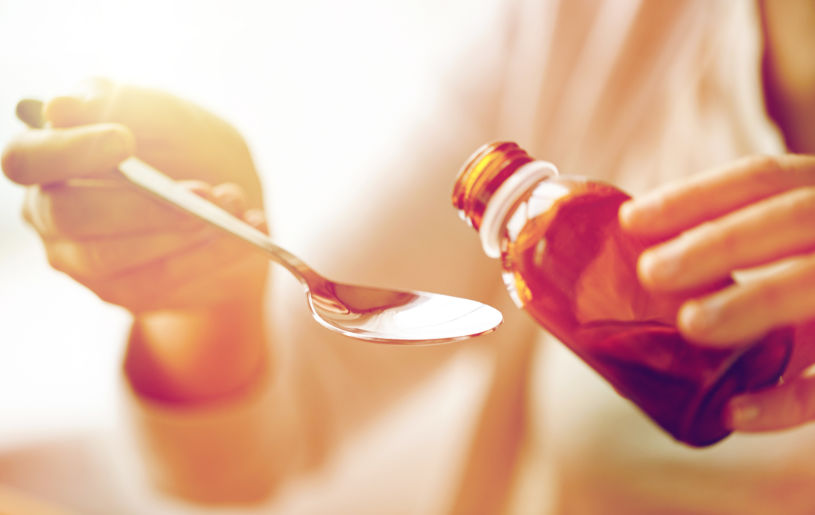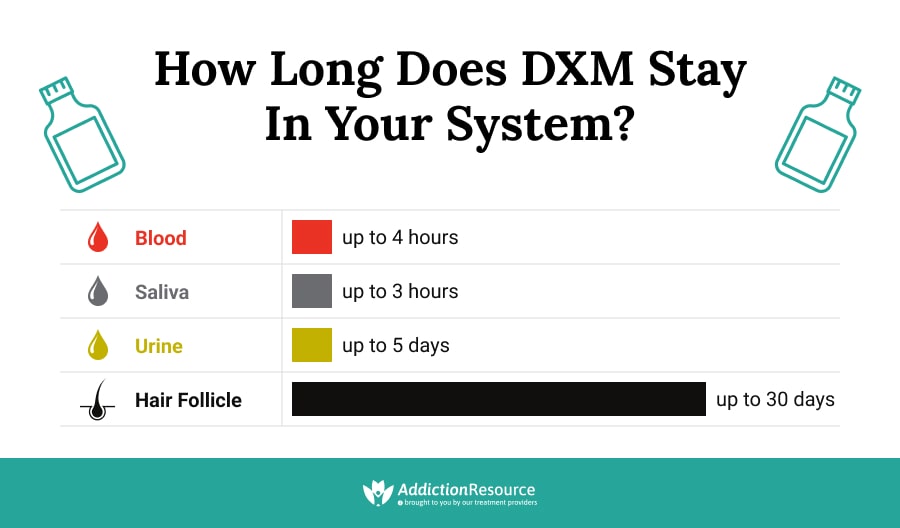DXM HBr or Dextromethorphan is an over-the-counter drug, and its main use is a cough suppressant. Dextromethorphan does not cure a cough or speed up the healing process but merely gives temporary relief. Although this drug is safe and effective if used properly, it is essential to know that its inappropriate use or DXM side effects may cause dangers to health.
Table Of Contents:
According to a survey in 2020, 3.7% of teens in the United States used the drug improperly. Read along to find the information about the Dextromethorphan brand names, DXM abuse statistics, dangers of abuse, DXM and alcohol interactions, addiction treatment, and recovery process.
DXM addiction is possible. In spite of the good and safe profile of this drug, it can be addictive. According to the DEA, DXM is now a “drug of concern” due to high dependence and abuse rates.
More About Opioids:
What Is Dextromethorphan?
The DXM drug class is known as morphinan (which describes many psychoactive drugs), and it’s derived from opiates but has a very different use and effect. It does not alleviate pain, but it can be addictive in very high doses and have a very long and problematic DXM withdrawal timeline. According to its drug classification, it’s a safe and effective medicine for adults at therapeutic doses.
Is DXM a Controlled Substance?
Dextromethorphan is not a Scheduled Drug. This means that it’s considered to be a safe medication that doesn’t need regulatory control. As a result, this drug is an uncontrolled medication that can be bought over the counter.
DXM Mechanism of Action
The Dextromethorphan mechanism of action works as NMDA Receptor Antagonists. When nerves in the airways and lungs detect an irritating substance or fluid, they send a chemical signal to the brain’s medulla oblongata, where the cough reflex is initiated. However, to be perfectly blunt, information about the mechanism of Dextromethorphan’s action is not well understood. It is known that this drug acts on multiple sites within the CNS as Sigma-1 receptor agonist, Nicotinic receptor antagonist, Serotonin and Norepinephrine transporter inhibitor, as well as Voltage-gated calcium channel inhibitor.
However, the mechanisms with which DXM is thought to cause cough suppression are related to a specific region in the brain, known as the Nucleus tractus solitarius. This is the site where peripheral information from the lungs is integrated/conveyed with/to medullary respiratory centers and where the signals for a cough reflex are initiated.

DXM Generic And Brand Names
DXM generic is an antitussive substance available in syrups, lozenges, tablets, gel capsules. All these medicines with DXM have different brand names such as Robitussin, Dimetapp, Tylenol Cough and Cold, and Bronchophan, and many other.
It is available in different dosage forms with different DXM dosage strengths. Although there are various forms of DXM on the market, only a medical professional is able to help a patient prescribe the DXM drug properly.
Overview of DXM Abuse And Addiction
DXM HBr is an affordable drug, which increases a high potential for abuse every year, due to its possible narcotic properties in high doses. The biggest problem with this medication is that a good number of youngsters turn to abuse Dextromethorphan cough syrup in the USA. This happens because this medicine produces euphoria-like and psychoactive effects when taken overprescribed.
An active ingredient of Dextromethorphan belongs to the morphinan class but works very differently from other drugs with similar morphine structure. This substance may act as a dissociative anesthetic in very high doses. This pushes people to experiment with the amount of the drug and very often leads to DXM abuse and addiction.
DXM Abuse Statistics
According to the DEA, this substance is now a “drug of concern” due to high dependence and DXM abuse rates. It is challenging to have the full picture of Dextromethorphan abuse because the drug has legitimate medicinal use; abuse only occurs when the dosage is exceeded. Mostly, statistics are sourced from emergency visits to the ER or from self-reported surveys, which may not give the real picture.
In 2006, the National Survey on Drug Use and Health (NSDUH) reported that approximately 3.1 million people aged between 12-25 have abused Dextromethorphan. This survey also indicated that in adults, more men than women were prone to abuse this substance.
Other reports also indicate that Dextromethorphan drug addiction sends approximately 6,000 teenagers to the ER each year. Most of these cases happen due to DXM and alcohol interaction.
In 2008, the Consumer Healthcare Products Association ordered to place a warning icon on the packages of Dextromethorphan products in the United States. This way, they wanted to warn people about health issues associated with abusing this drug and prevent the addiction from spreading.
In 2012 the CHPA launched a propaganda campaign on the Internet that distributed video materials explaining the negative effects and the possible adverse consequences of the abuse of this drug.
How Does DXM Addiction Develop?
DXM addiction is possible. In spite of the good and safe profile of this drug, it can be addictive. Addiction appears when a patient has been using the medicine for a long period of time. Additionally, when the medicine is frequently used, it is hard to identify it immediately. When a person is abusing Dextromethorphan, there are a few pointers that can sell them out.
These Are Some of the Signs of DXM Abuse That Need to Be Carefully Tracked:
- Loss of interest in social activities such as sports
- The appearance of being unkempt
- Eating poorly
- Changes in sleeping patterns
- Reduced performance
- Chronic lateness
- Acquiring new friends
- Aggressive behavior
Apart From the Signs, Many DXM Addiction Symptoms Can Also Be Observed in a Person Abusing It:
- Looks intoxicated but without the smell of alcohol
- Slurred and incoherent speech
- Taking cyclical or repetitive actions such as walking to the room, putting the lights on, walk out, then come back and repeat the same action
- Doing the “Robo-walk” (a rigid and uncoordinated movement named after Robitussin)
- Lack of situational awareness
Taking note of the signs of DXM abuse is very helpful for every user. If a person is suspecting someone abusing the medication, professional help such as drug rehab treatment and recovery are great options to help the abuser get back on track.
DXM addiction comes with many adverse effects and risks. Taking too much Dextromethorphan can significantly damage the health.
Who Is Most at Risk of DXM Abuse And Addiction
Dextromethorphan was approved for use by the FDA in the 1950s as a cough suppressant, and it was reported in 2019 that 1 out of every 27 teens abused OTC medications such as Dextromethorphan. Furthermore, a six-year retrospective review study conducted in California in 2008 showed a ten-fold increase in teen DXM addiction rates from 1999 to 2004.
In spite of government efforts to stop the abuse of Dextromethorphan cough syrup by teenagers, it is easily accessible through stores and online sources. Dextromethorphan extraction from syrups is relatively easy, making it even harder to control the abuse among teens.
Dextromethorphan Medical Use Is Safe for Teens, but Here Are a Few Things a Parent Can Do to Prevent and Care for Their Teen From Abusing Dextromethorphan:
- Educate teens about the dangers of abusing the substance
- Regularly inspect rooms for any empty medicine boxes or strange powders
- Monitor online purchases
- A parent can do a DXM drug test for a teen to confirm or rule out suspicions of abuse
It is important for parents to care for their teens by never assuming that they are too innocent to abuse this drug. DXM addiction is real and may lead to severe effects such as liver damage and respiratory complications. Furthermore, DXM can become a gateway to hard drugs for teenagers.
Possible Dangers Of DXM Abuse
DXM addiction comes with many adverse effects and risks. Taking too much Dextromethorphan can significantly damage the health (nervous system), so that one may get a chemical psychosis. This may result in a mental imbalance that may require hospitalization. Poor judgment, visual distortions, and irrational behavior may also occur, putting the individual at high risk for causing or being involved in an accident. This may lead to a DXM HBr hangover, and this soon becomes a vicious cycle. Death is rare, but the most significant risk which may appear because of abusing Dextromethorphan.
According to the National Institute on Drug Abuse (NIDA), Excessive Consumption May Lead to the Following Dxm Abuse Long-Term Effects:
- Liver toxicity
- Respiratory system depression on rare occasions
- Depression and mania
- Impaired memory
- Delusions
- Cognitive impairment
- Inability to focus
- Panic attacks
- Failure to make long term goals
If a person is suspecting someone experiencing these dangers of DXM abuse, immediate medical treatment, care, and help must be given to avoid the possible occurrence of worse scenarios.

DXM Overdose Dangers
DXM abuse will not only lead to addiction but will also lead to life-threatening overdose. Aside from the dangerous physical signs of overdose such as tachycardia and seizures, some other signs and symptoms of overdose are the following:
- Breathing problems
- Bluish coloration of nails
- Convulsions
- Muscle twitches
Hyperexcitability and somnolence are the most common behavioral Dextromethorphan overdose symptoms. Because of this, it is important to seek emergency care or treatment whenever the signs and symptoms above are observed, as these are more likely to result in coma or death.
Dextromethorphan Withdrawal
After abusing the drug for a long time (from a few months to a few years), people develop a DXM addiction. In some rare cases, the individual may establish physiological dependence as well. When this happens, the person will experience DXM withdrawal symptoms. Despite the Dextromethorphan MOA activity doesn’t manifest addictive properties, this drug may cause specific effects on the body after the stop of using it for a long time.
DXM Withdrawal Symptoms And Effects
DXM withdrawal symptoms usually are not harmless. Withdrawal effects (especially heavy Dextromethorphan use withdrawal symptoms) can take a toll on the health of one’s body, in addition to the internal damage being done by the overuse of the drug itself. These can manifest as:
- excessive sweating
- flaring up of a hypersensitive nervous system
- sudden drops and hikes in blood pressure
- the patient being constantly lightheaded and fatigued
- impaired judgment and mental clarity
- insomnia
- restlessness
- disassociation
- high blood pressure
- an excessively rapid heart rate
- weight loss as a result of these symptoms
- depression, high levels of anxiety, suicidal ideation
Both the psychological withdrawal effects of Dextromethorphan or the physical withdrawal symptoms all depend on the ability of the user’s body to “tolerate” the lack of the drug in the system. In most cases, the DXM withdrawal symptoms require medical attention. Therefore, the presence of a healthcare physician or rehabilitation and addiction expert during a Dextromethorphan detox and treatment is crucial.
How Long Does DXM Withdrawal Last?
The withdrawal timeline for Dextromethorphan always varies from case to case. Sufficient in-depth research is still not done, and the exact timeline is dependent on factors such as metabolism, and how much of the drug was in the patient’s system (and for how long) at the start of the detox. While symptoms grow more gradually as compared to other drugs, conducted surveys indicate that it can last up to at least a few weeks.

How Long Does DXM Stay in Your System?
How long does the DXM drug stay in the system? DXM HBr is absorbed quickly and has an elimination half-life of 2-4 hours. However, in extensive metabolizers, half-life time may be shorter than 2 hours. On the other hand, poor metabolizers may need up to 24 hours to eliminate Dextromethorphan from the system completely.
The Time Dextromethorphan Stays in Urine, Blood, Hair, and Saliva Is as Follows:
- Urine – As this cough syrup drug isn’t a standard part of most drug tests, there are no definite answers to this question. A temporary period of 5 days is often accepted as the upper limit. Dextromethorphan urine tests are still rarely used.
- Blood – In short metabolizers, traces of this substance can be found in blood plasma 4 hours after ingestion. After the first few hours, all traces of the chemical are eliminated from the blood, so this drug test method isn’t the most popular one. This also means that the Dextromethorphan military drug test isn’t something to be afraid of.
- Hair – Hair follicle drug tests are the most extensive drug tests available, and these tests will be able to detect this chemical month after consumption (the exact length is unknown).
- Saliva – A group of researchers from the US developed an efficient method for detecting Dextromethorphan in saliva. This is still a novel technique, and it is unclear whether it can detect the medication days after ingestion. However the recent study estimates timeline for saliva at 3 hours.
Another quite fascinating aspect relating to Dextromethorphan is information about its metabolism. Individuals metabolize Dextromethorphan at different rates. This means that an extensive metabolizer, which most of the consumer population falls under, will metabolize 30mg of Dextromethorphan rapidly and only allow 1-2% of the oral drug to cause antitussive effects for 2-3 hours. Whereas the same dose in a poor metabolizer will have oral availability of 80% causing effects for up to 19 hours.
As such, variabilities in the metabolism can either lead to a failed therapeutic outcome or potential adverse health effects.
Does Dextromethorphan Show Up on a Drug Test?
It is not easy to answer this question. This substance isn’t a part of standard drug tests. Even extended drug tests don’t include it as their essential part. And there is a simple reason for this – Dextromethorphan is legal. However, with more cases of adolescent DXM addiction, more and more companies have started to include Dextromethorphan as a standard part of their drug tests.
Dextromethorphan addiction treatment focuses on dealing with the immediate effects of addiction. This may include treating withdrawal symptoms as well as reducing psychological dependence to allow one to resume a healthy lifestyle.
DXM And Alcohol
Taking DXM and alcohol together is dangerous to one’s health. Both of these substances are Central Nervous System depressants which means these two decrease the activity of the neurons in the brain.
When They Are Taken Together, the Following Dangers Might Occur:
- Extreme nausea and prolonged vomiting
- Hot flushes
- Extreme anxiety
- Fatal seizures
Furthermore, the National Institute of Alcohol Abuse and Alcoholism has warned about the interaction of these two substances. Therefore, there are additional risks when taking Dextromethorphan medication as well as a substance containing ethanol, and the combination can affect a person’s health.
DXM And Weed
When mixing DXM and weed, a significant interaction may occur. The combination of DXM and weed has such effects as delusions, agitation, mood changes. Taking weed and this drug may increase the risk of many dangerous side effects to the health, such as hallucinations, impaired thinking, profound loss of coordination, increased heart rate, liver damage. After taking this drug and cannabis, the concentration may diminish, thus making it hazardous to drive or operate heavy machinery. At times, Dextromethorphan and marijuana abuse could lead to death.

Dextromethorphan Interaction With Antidepressants
Mixing this drug with antidepressants could lead to serotonin syndrome. This happens when the brain gets flooded with too much serotonin. The most common side effects of taking these two together are dry mouth, agitation or restlessness, excessive sweating and high fever, loss of muscle coordination, seizures, nausea, diarrhea or constipation, headache, irregular heartbeat, confusion, delirium, and hallucinations, libido changes.
For example, Dextromethorphan and Xanax interactions can be dangerous to a patient’s health. There is clinically significant interaction between Dextromethorphan and Xanax, which requires using it only under special circumstances. Mixing these two could decrease the respiratory system activity, posing the risk of death. Dizziness with poor motor coordination is commonly associated with the interaction of these drugs, and there is currently no scientific study that sanctions a safe Dextromethorphan amount that can be combined with Xanax.
DXM Interaction With Stimulants
As in the case of antidepressants, the interactions between Dextromethorphan and amphetamine-containing medicines can also suddenly heighten the serotonin level in the body and this is dangerous to the health. Therefore, such an interaction is likely to increase blood pressure levels and heartbeat rates and induce an uncomfortable feeling, agitation, and restlessness. Using stimulants together with this drug could cause changes in blood pressure, hallucinations and confusion, excessive sweating, shaking or shivering, nausea, diarrhea, stomach cramps, and vomiting, incoordination, blurred vision.
For instance, Dextromethorphan and Adderall interaction are not safe, even when Dextromethorphan is used to offset Adderall tolerance, as a clinically significant interaction may appear. In a Dextromethorphan and Adderall combo, the former acts as an NMDA receptor antagonist, and this could reduce the onset of amphetamine tolerance. Effects of mixing Dextromethorphan and Adderall are seizures, muscle spasms, and confusion.
Mixing Dextromethorphan With Opioids
The interaction between Dextromethorphan and opioids could cause severe and harmful effects by increasing the amount of serotonin in the body. The interactions between these two are severe, and the results of this could be: changes in body temperature and blood pressure, heart palpitations, confusion and agitation, restlessness and seizures, heavy sweating and shivering, fever, nausea and vomiting, stomach upsets.
For example, Dextromethorphan and Kratom interaction must be avoided. There are many deaths, cardiac arrests, and coma cases associated with misusing these two, and hence, combining the two is not advisable. When used with a potentiator, kratom side effects last longer. A Dextromethorphan-Kratom combo can have serious side effects on health such as lack of coordination, eye wobbles, constipation, liver damage, and tachycardia.
DXM Addiction Treatment And Recovery
For anyone suffering from DXM addiction, there is much that can be done for the recovery of the patient. As much as there is no pharmaceutical treatment for DXM addiction, there are alternative therapies that work effectively. Dextromethorphan addiction treatment focuses on dealing with the immediate effects of addiction. This may include treating withdrawal symptoms as well as reducing psychological dependence to allow one to resume a healthy lifestyle.
Some Approaches That May Be Effective Include:
- Professional detox. Here, the individual is guided by a qualified professional through a detoxification process. The aim is to pump out the drug from the individual’s system. Detox needs to be followed up with additional addiction treatment and care; otherwise, it will result in relapse.
- Cognitive-behavioral recovery therapy. This educates the individual on how to avoid situations that expose them to addiction. This may include having alternatives such as using cold medicine without Dextromethorphan when treating a cold.
- Contingency management. Here the individual is rewarded for abstinence to encourage them to stick through with the addiction treatment program.
- Group therapy, where individuals meet up with people with the same or similar addictions to encourage, help, and care for each other in their addiction recovery journey.
- Long-term follow-up to prevent relapsing back to addiction.
Once a person has received treatment for Dextromethorphan addiction, they will need recovery to resume a healthy lifestyle and keep away from abusing this drug. Checking into a suitable rehab center may help keep the individual away from external influences that may trigger relapse back to addiction.
Frequently Asked Questions
Is DXM an Opiate?
Dextromethorphan is not classified as an opiate. Opiates do structurally represent morphine, but DXM HBr type is structurally similar to opioid drugs. So, this drug’s category belongs to a synthetic substance that only mimics some of the behaviors of opiates.
Hope Without Commitment
Find the best treatment options. Call our free and confidential helpline
Most private insurances accepted
Page Sources
- Bryner, J. K., Wang, U. K., Hui, J. W., Bedodo, M., MacDougall, C., & Anderson, I. B. (2006). Dextromethorphan abuse in adolescence: an increasing trend: 1999-2004. Archives of pediatrics & adolescent medicine, 160(12), 1217-1222.
- Foong, A. L., Grindrod, K. A., Patel, T., & Kellar, J. (2018). Demystifying serotonin syndrome (or serotonin toxicity). Canadian Family Physician, 64(10), 720-727.
- “Harmful Interactions.” National Institute on Alcohol Abuse and Alcoholism, U.S. Department of Health and Human Services, www.niaaa.nih.gov/publications/brochures-and-fact-sheets/harmful-interactions-mixing-alcohol-with-medicines.
- Johnston, L., Miech, R., O'Malley, P., Bachman, J., Schulenberg, J., & Patrick, M. (2020). Monitoring the Future national survey results on drug use, 1975-2019: Overview, key findings on adolescent drug use.
- National Institute on Drug Abuse. (2016). Monitoring the Future Study: trends in prevalence of various drugs. National Institute on Drug Abuse. (2016). Monitoring the Future Study: trends in prevalence of various drugs.
- National Institute on Drug Abuse. (2021, May 03). Commonly Used Drugs Charts. Retrieved from https://www.drugabuse.gov/drug-topics/commonly-used-drugs-charts#Dextromethorphan
- National Survey on Drug Use and Health (NSDUH) Population Data. (n.d.). Retrieved from https://www.datafiles.samhsa.gov/dataset/national-survey-drug-use-and-health-2006-nsduh-2006-ds0001
- Spangler, D. C., Loyd, C. M., & Skor, E. E. (2016). Dextromethorphan: a case study on addressing abuse of a safe and effective drug. Substance abuse treatment, prevention, and policy, 11(1), 1-7.
- Storrow, A. B., Magoon, M. R., & Norton, J. (1995). The dextromethorphan defense: dextromethorphan and the opioid screen. Academic Emergency Medicine, 2(9), 791-794.
- United States Drug Enforcement Administration. Drugs of Concern | DEA.gov. (n.d.). https://www.dea.gov/taxonomy/term/311.
- Vo, K., Neafsey, P. J., & Lin, C. A. (2015). Concurrent use of amphetamine stimulants and antidepressants by undergraduate students. Patient preference and adherence, 9, 161.
- WHO Expert Committee on Drug Dependence, & World Health Organization. (2012). WHO Expert Committee on Drug Dependence: thirty-fifth report. World Health Organization

 Authored by
Authored by  Reviewed by
Reviewed by 
